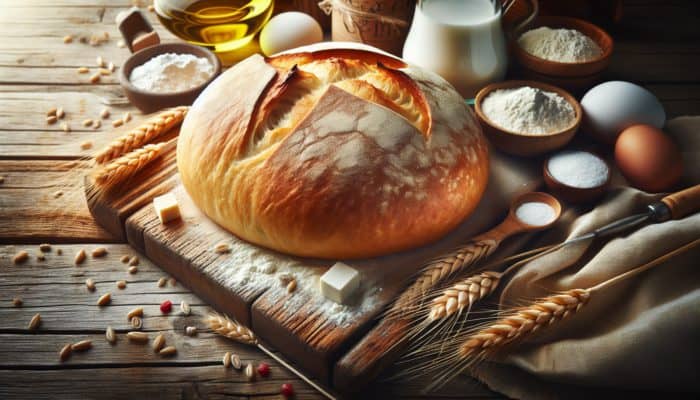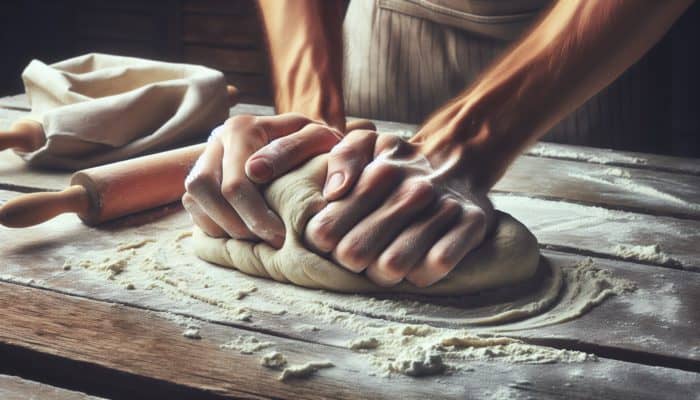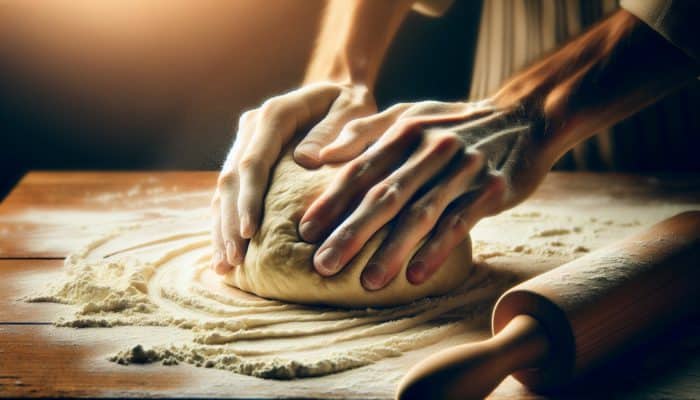Essential Insights into Dough Kneading for Perfect Bread
What Are the Key Ingredients for Soft Bread?

How to Knead Dough for Soft Bread: To craft irresistibly soft bread, you need to understand the essential ingredients: flour, Water, yeast, and salt. Each of these components contributes significantly to the overall quality and texture of the bread. The flour serves as the backbone of the bread, with its protein content—especially gluten—being crucial for the dough's elasticity and chewiness. Selecting the right type of flour—whether all-purpose, bread flour, or wholemeal—can dramatically alter the final result. Water acts as a facilitator, activating gluten, hydrating flour, and dissolving yeast and salt, all of which are vital to the fermentation process. Yeast is your fermentation agent, converting sugars into carbon dioxide, which causes the dough to rise. Finally, salt enhances the flavour and fortifies the gluten structure, resulting in a more robust and flavoursome loaf. Mastery of these ingredients and their interactions is vital for successful kneading and achieving that coveted soft texture.
How Long Should You Knead Your Dough for Optimal Results?
The kneading time can vary widely depending on factors such as the type of dough you are working with and the texture you want in your bread. Generally, kneading for 10-15 minutes is a good benchmark for crafting soft bread. This timeframe is essential for effective gluten development, which is the cornerstone for achieving a soft, airy crumb. Rather than relying solely on a timer, it is crucial to observe the dough's characteristics. Initially, the dough should appear rough and shaggy, but as you progress, it will transform into a smooth, elastic form. An important aspect to check for is a decrease in stickiness, as the dough becomes more manageable. Relying on your visual and tactile senses—feeling for slight elasticity and smoothness—serves as a more accurate indicator of readiness than a strict countdown. The ultimate goal is to cultivate the gluten network sufficiently to ensure the bread rises beautifully and boasts a delightful texture post-baking.
What Is the Perfect Dough Consistency for Soft Bread?
Achieving the ideal dough consistency is pivotal to bread-making success. The perfect dough should be smooth and elastic, with a slight tackiness that is neither excessively sticky nor dry. If the dough is too sticky, it can hinder your ability to handle and shape it effectively, while a dry dough may result in a dense, crumbly loaf. Aim for a dough that maintains its shape yet remains pliable enough to stretch without tearing. A practical approach to test your dough's consistency is to perform the windowpane test: take a small piece of dough and gently stretch it between your fingers. If it can stretch into a thin, translucent sheet without breaking, your dough has reached the right consistency. This indicates that sufficient gluten has developed to trap the gases produced during fermentation, resulting in a beautifully soft final product.
Effective Techniques for Successful Dough Kneading

How to Master the Stretch-and-Fold Method for Dough Kneading?
The stretch-and-fold method is a highly effective technique for developing gluten while keeping the dough hydrated and airy. This approach is especially beneficial for high-hydration doughs, which can be challenging to knead using traditional methods. To master this technique, follow these detailed steps:
- Begin with a lightly floured work surface and position your dough in the centre.
- Gently stretch one side of the dough upwards and fold it over the centre.
- Repeat this stretching and folding technique on each side, working your way around the dough until all four sides have been folded.
- Allow the dough to rest for 20-30 minutes before repeating the stretch-and-fold process.
- Continue this cycle for the desired number of folds (typically 3-4) during the first rise.
- Note how the dough becomes increasingly elastic and smooth with each cycle.
- Finally, let the dough complete its bulk fermentation before shaping and baking it.
This method not only promotes gluten development effectively but also incorporates air into the dough, resulting in a light and airy texture.
Can Over-Kneading Dough Lead to Issues?
Absolutely, it is possible to over-knead your dough, which can result in tough, dense bread. Over-kneading occurs when excessive mechanical action breaks down gluten strands rather than allowing them to develop. Symptoms of over-kneaded dough include an overly tight texture that resists stretching and a shiny, almost leathery surface. If you notice these characteristics, it may be too late to restore its softness. To avoid over-kneading, keep a close watch on the dough throughout the kneading process, focusing on its texture rather than adhering strictly to a timer. Remember, the aim is to cultivate a well-developed gluten network that can effectively trap gases without compromising the dough's integrity.
How to Effectively Use a Dough Scraper in Kneading?

A dough scraper is an indispensable tool for managing sticky dough and streamlining the kneading process. This simple yet effective device lets you lift, fold, and turn the dough without adding excessive flour, which can result in a denser loaf. To make the most out of a dough scraper, consider the following tips:
- When the dough clings to your work surface, use the scraper to lift it, reducing the need for excess flour gently.
- Utilise the scraper to cut the dough into manageable sections for dividing and shaping.
- The scraper can assist with folding the dough during the stretch-and-fold method, making air incorporation easier.
- After kneading, use the scraper to transfer the dough into a bowl for rising, ensuring it retains its shape.
By incorporating a dough scraper into your kneading routine, you can enhance your control over the dough, ultimately achieving better results with less effort.
Pro Tips on Perfecting Your Dough Kneading Techniques
What Insights Do Professional Bakers Offer on Kneading?
Professional bakers possess a wealth of knowledge regarding kneading techniques that yield exceptional results. For example, many recommend employing the autolyse technique, which involves mixing flour and water and allowing it to rest before incorporating yeast and salt. This method allows the flour to hydrate, fully enhancing gluten development. Moreover, bakers suggest kneading by feel rather than strictly by time, encouraging home bakers to tune into the dough’s texture and elasticity. Real-world examples from bakeries worldwide—from artisanal shops in Paris to rustic bakeries in Tuscany—underscore the importance of patience in kneading, urging bakers to take their time to achieve the perfect dough consistency. Adopting these expert techniques into your practice will elevate your bread-making skills, resulting in more consistent, delightful results.
How Does Temperature Influence the Kneading Process?
Temperature is a crucial factor in the kneading process, impacting overall dough behaviour. Warmer environments can expedite fermentation, potentially requiring shorter kneading times to prevent overdevelopment of gluten. Conversely, cooler temperatures often necessitate extended kneading periods to achieve the desired elasticity. In tropical regions, for instance, bakers might need to adapt their kneading techniques to accommodate the rapid fermentation caused by higher ambient temperatures. Additionally, the temperature of your ingredients can influence dough performance; warm water can accelerate yeast activation, while colder components can slow it down. Understanding how temperature affects your dough provides valuable insights for adjusting your kneading and fermentation practices for optimal outcomes.
What Common Mistakes Should You Avoid When Kneading Dough?
Kneading is a skill that requires practice, and being aware of common mistakes can significantly improve your bread-making results. A prevalent error is uneven kneading, where certain sections of the dough receive more attention than others, resulting in an inconsistent texture. To circumvent this, concentrate on working the dough uniformly, ensuring that every part is adequately kneaded. Another common mistake is neglecting essential rest periods. Failing to allow the dough to rest can lead to tough bread, as the gluten won’t have sufficient time to relax. Additionally, failing to adapt kneading techniques to the dough's hydration level can lead to unmet expectations. Recognising these common pitfalls will empower you to refine your kneading approach, ultimately enhancing the quality of your bread.
How Can You Identify When Dough Is Properly Kneaded?
Recognising when your dough is properly kneaded is essential for successful bread-making. Signs of well-kneaded dough include a smooth, elastic texture that springs back when gently pressed. One definitive test is the windowpane test, where a small piece of dough is stretched thinly without tearing. If the dough can achieve a translucent sheet, it indicates adequate gluten development. Additionally, properly kneaded dough should feel slightly tacky but not sticky, which facilitates easy handling. Paying attention to these indicators during kneading ensures your dough is ready for the next phase of bread-making.
Essential Tools and Equipment for Effective Kneading
Is Using a Stand Mixer More Effective Than Hand Kneading?
Both stand mixers and hand kneading have distinct advantages, and the choice largely depends on personal preference and the specific requirements of your dough. A stand mixer can save considerable time and effort, kneading dough efficiently with minimal physical exertion. This method is particularly advantageous for larger batches or high-hydration doughs that require significant kneading time. However, hand kneading offers a more intimate connection with the dough, providing tactile feedback that many bakers cherish. This hands-on approach allows for better adjustments based on the dough's behaviour. Many bakers advocate a hybrid method: using a stand mixer for the initial kneading and finishing by hand to achieve the perfect consistency. Ultimately, the best approach is one that aligns with your skill level and baking aspirations.
What Type of Bowl Enhances the Kneading Process?
Selecting the right bowl for kneading can significantly streamline your bread-making experience. Ideally, a wide, shallow bowl is the best option, as it allows easier access to the dough and better control during kneading. Non-stick or lightly oiled surfaces are advisable to prevent sticking, which can complicate kneading efforts. Bowls made from materials such as glass, stainless steel, or ceramic offer durability and ease of cleaning. Additionally, selecting a bowl that accommodates the dough’s rise is essential; it should be sufficiently large to allow for expansion during fermentation. By choosing the right bowl, you can optimise your kneading technique and create a more enjoyable baking experience.
Can You Knead Dough on Any Surface?
While it’s possible to knead dough on various surfaces, certain materials can enhance the process. Marble or granite countertops are particularly ideal due to their smooth surfaces and cool temperatures, which can help prevent the dough from overheating during kneading. However, wooden boards can also be effective, offering a natural surface that absorbs some moisture and helps manage stickiness. It’s crucial to ensure that the surface is clean and free of debris to maintain the dough's integrity. The key is to select a stable, non-porous surface that allows for easy manipulation and control of the dough during kneading, leading to better handling and a superior final product.
The Science of Dough Kneading
How Does Gluten Development Contribute to Bread Structure?
Gluten development is fundamental to bread structure, and understanding its mechanics is essential for successful baking. When flour is combined with water, two proteins—glutenin and gliadin—begin to form gluten. Kneading aligns these proteins into long strands, creating a network that traps gas bubbles released during fermentation. This network imparts elasticity and chewiness to the bread. The more you knead, the more developed the gluten network becomes, leading to a softer, more pliable dough. When properly developed, gluten forms the framework that supports the dough’s rise, contributing to both the structure and texture of the finished loaf. Understanding the science behind gluten allows bakers to manipulate their techniques to achieve specific outcomes, whether aiming for a soft sandwich loaf or a crusty artisan bread.
What Role Does Yeast Play in the Kneading Process?
Yeast is a vital component in the bread-making process, significantly impacting the dough's behaviour during kneading. As yeast ferments, it consumes sugars, producing carbon dioxide and alcohol that contribute to the dough’s rise and flavour. Proper kneading ensures even distribution of yeast throughout the dough, facilitating consistent fermentation. Additionally, as the dough is kneaded, the gluten structure develops, helping trap the gases produced by the yeast. An even distribution of yeast results in a uniform rise, enhancing the loaf's texture consistency throughout. Understanding the role of yeast and its interaction with kneading techniques empowers bakers to create visually appealing and deliciously flavourful loaves.
How Does Kneading Influence the Final Texture of Dough?
Kneading significantly impacts the final texture of the dough, influencing everything from crumb structure to overall softness. During kneading, gluten strands develop and align, forming a network that captures the gases produced during fermentation. This network is crucial for achieving a light and airy crumb in the finished bread. The degree of kneading is directly related to the dough's strength and elasticity, determining how well it rises and how soft it becomes. Insufficient kneading can result in dense, heavy bread, while over-kneading can lead to a tough texture. Thus, mastering the kneading technique is essential for achieving a desirable final product, whether for a crusty sourdough or a soft sandwich loaf.
Essential Tips for Perfecting Your Kneading Technique
How Can You Recognise When Dough is Properly Kneaded?
Identifying the signs of properly kneaded dough is crucial for successful bread-making. Key indicators include a smooth, elastic texture and the ability to pass the windowpane test. Here are some signs to observe:
- The dough feels smooth and pliable, free from sticky patches.
- It springs back when poked gently, indicating good elasticity.
- The surface appears slightly shiny, reflecting proper hydration and gluten development.
- It can stretch thinly without tearing, successfully passing the windowpane test.
These characteristics signify that the dough has reached the ideal state for fermentation and baking. By honing your ability to recognise these signs, you can significantly improve your bread's texture and achieve consistently delightful results.
Should You Incorporate Rest Periods During Kneading?
Incorporating rest periods during kneading is essential for optimal gluten development and overall texture. Allowing the dough to rest briefly facilitates gluten relaxation, reducing the effort required in subsequent kneading sessions. This relaxation phase can help prevent overworking the dough, which may lead to toughness. Typically, a 20-30 minute rest period after a kneading series can enhance the dough's extensibility. During this time, the gluten aligns and develops more uniformly, resulting in a softer final loaf. Integrating rest periods into your kneading routine can significantly improve the quality of your bread, making your baking experience more enjoyable.
What Advanced Kneading Techniques Can You Try?
For those eager to refine their kneading skills, several advanced techniques can improve dough development. The slap-and-fold method is a dynamic technique in which the dough is slapped onto the work surface and then folded over itself. This method effectively develops gluten while incorporating air into the dough, contributing to a lighter texture. Another technique is coil folding, in which the dough is lifted and coiled back on itself during bulk fermentation. This gentle approach enhances gluten strength while maintaining the dough's airy quality. Experimenting with these advanced techniques can yield unique textures and flavours in your bread, enabling you to tailor your approach to suit various recipes.
Proven Strategies for Perfecting Your Dough Kneading
What Are the Best Practices to Follow When Kneading?
Implementing best kneading practices can significantly improve your bread-making results. Firstly, maintaining a consistent rhythm is vital; knead the dough with uniform pressure, allowing it to stretch and fold evenly. Secondly, incorporate rest periods as necessary, enabling the gluten to relax and making it easier to work with the dough. Additionally, refrain from adding excessive flour during kneading; instead, utilise a dough scraper to manage stickiness while keeping the dough hydrated. Finally, remain attuned to the dough's behaviour—its texture, elasticity, and responsiveness should inform your kneading process. By following these actionable steps, you can ensure your kneading technique yields a soft, desirable loaf of bread.
How Can You Adapt Kneading Techniques for Different Dough Types?
Different dough types require tailored kneading techniques, as variations in hydration and ingredients affect the approach. For instance, high-hydration doughs, such as those used for ciabatta or focaccia, may benefit from the stretch-and-fold method rather than traditional kneading, which facilitates gluten development without overworking the dough. Conversely, richer doughs containing fats or sugars may require more kneading time to develop a strong gluten network, as these components can hinder gluten formation. Understanding the specific needs of your dough will empower you to adjust your kneading method effectively, ensuring optimal results for various bread recipes.
What Advantages Does Proper Kneading Offer?
Proper kneading provides numerous benefits that enhance the overall quality of your bread. Firstly, it fosters a robust gluten structure, essential for trapping gases during fermentation and creating a light, airy crumb. Additionally, well-kneaded dough yields a uniform texture, ensuring even distribution of ingredients and flavours throughout the bread. A strong gluten network also contributes to the bread’s structural integrity, allowing it to rise effectively without collapsing during baking. Ultimately, mastering the kneading process is key to producing consistently delicious bread that is not only visually appealing but also delights the palate.
How Long Should You Knead Dough for Soft Bread?
The kneading duration for soft bread typically ranges from 10 to 15 minutes, but this can vary based on factors such as dough hydration and the type of flour used. It’s imperative to focus on the dough’s texture rather than strictly adhering to a timer; the objective is to achieve a smooth, elastic consistency that springs back when pressed. Pay attention to the dough's behaviour during kneading. If it becomes overly sticky, you may need to adjust your technique or take a brief rest to allow the gluten to relax. Ultimately, understanding your dough will help you determine the optimal kneading time to achieve the perfect soft bread.
What Tools Can Enhance Your Kneading Experience?
Using the right tools can streamline the kneading process and improve your results. A dough hook attachment for a stand mixer is invaluable for those who prefer a less physical approach, allowing for efficient kneading while minimising strain on your hands. Additionally, a dough scraper is essential for managing sticky dough and keeping your work surface tidy. A high-quality bench knife can also be beneficial for cutting and shaping dough efficiently. Moreover, investing in a high-quality mixing bowl with a non-stick surface can make kneading and handling easier. By equipping yourself with these tools, you can enhance your kneading technique and achieve more consistent results in your bread-making endeavours.
Troubleshooting Common Dough Kneading Issues
Why Is My Dough Excessively Sticky?
Excessively sticky dough can arise from several factors, most commonly excessive water or inadequate kneading. When too much water is added, the dough can become overly hydrated, making it challenging to handle. To rectify this issue, you can either reduce the water in your recipe or knead the dough longer to develop the gluten structure adequately. If the dough remains sticky, consider using a dough scraper to manage it without adding excessive flour, which can lead to a denser final product. Adjusting your hydration levels and kneading technique will significantly improve your dough's consistency.
How Can You Remedy Over-Kneaded Dough?
Over-kneaded dough can be salvaged, although it may require some patience. If you suspect your dough has been overkneaded, allow it to rest for 20-30 minutes. This resting period will enable the gluten to relax, making the dough easier to shape. After resting, gently shape it without applying excessive strain, then proceed with your recipe. While the final loaf may not achieve the same lightness as properly kneaded dough, this approach can help mitigate the effects of over-kneading, yielding a satisfactory result.
What Should You Do If Dough Tears During the Kneading Process?
If your dough tears during kneading, it may indicate either over-kneading or insufficient resting time. When dough tears, it can signal that the gluten has developed too tightly or that the dough hasn’t had adequate time to relax. In this scenario, allow the dough to rest for 10-15 minutes before continuing. This resting period will help the gluten relax, enabling gentler handling. During subsequent kneading, exercise caution and apply less force to prevent further tearing. Modifying your technique based on the dough's response will lead to better outcomes in future baking sessions.
Frequently Asked Questions About Dough Kneading
What is the best flour to use for soft bread?
Using bread flour or all-purpose flour with a higher protein content is ideal for soft bread, as it promotes gluten development and yields a light, fluffy texture.
How can I make my bread fluffier?
To achieve fluffier bread, ensure proper kneading to develop gluten and consider incorporating ingredients that enhance moisture, such as milk or yogurt.
What happens if I don't knead my dough sufficiently?
Insufficient kneading results in a weak gluten structure, leading to dense, poorly risen bread with a heavy texture and lacking the desired lightness.
Can I knead dough using a food processor?
Yes, a food processor can effectively knead dough, but be cautious of over-kneading, as this can easily result in tough dough.
How do I incorporate ingredients like nuts or seeds into my dough?
Introduce nuts or seeds during the last few minutes of kneading to ensure even distribution without compromising gluten development.
What should I do if my dough fails to rise?
If your dough does not rise, verify the yeast's freshness and ensure it was kept in a warm, draft-free environment for effective fermentation.
Is it necessary to use a scale for measuring ingredients?
Using a scale to measure ingredients ensures accuracy, leading to more consistent results in your bread-making endeavours.
Can I freeze my dough before baking it?
Yes, dough can be frozen before baking. Ensure it's adequately wrapped to prevent freezer burn, and allow ample time to thaw and rise before baking.
What is the purpose of adding sugar to bread dough?
Sugar enhances flavour, aids in browning during baking, and serves as food for yeast, promoting fermentation for a better rise.
How do I achieve a crispy crust on my bread?
To attain a crispy crust, bake the bread in a preheated oven and consider adding steam during the initial few minutes of baking.

